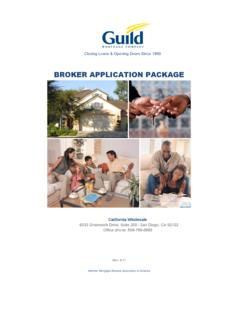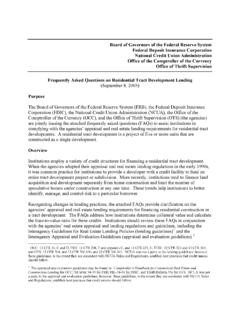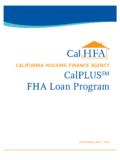Transcription of RURAL HOUSING UNDERWRITING GUIDELINES
1 RURAL HOUSING UNDERWRITING GUIDELINES . PROGRAM ELIGIBILITY. Borrower Eligibility In order to be eligible for a RURAL Development guaranteed loan, the Borrowers' adjusted household income cannot exceed the maximum allowable income limit set forth in RURAL Development Instruction 1980-D , Exhibit C (use moderate-income limits). ( ). The borrower must not have sufficient assets to obtain other traditional conventional financing. The borrower may, however, qualify for an FHA or VA loan. In other words, applicants may have liquid assets and be eligible to participate in the GRH Program. Those assets, however, should not be sufficient to meet the down payment and closing cost requirements associated with a conventional uninsured mortgage product (LTV 80%). This means applicants do have a choice of USDA-Guaranteed RURAL HOUSING , FHA, VA, or a conventional mortgage product with private mortgage insurance.
2 In the Chase- RURAL Development program, the appraisal determines the maximum loan amount. The applicant may borrow up to 100% of the appraised value for purchase and refinance transactions. The guarantee fee can be financed above the appraised value. An annual fee of is incurred on both purchase and refinance transactions. The Chase Guaranteed RURAL HOUSING Purchase Program Features Closing costs may be financed when there is equity above the contract price as supported by the appraisal. (Discount points, however, are only eligible for financing for low income households as defined by RURAL Development.). Seller contributions without any limitation are available to assist the borrower in paying closing costs. If they exceed 6% of the sales price, comparable sales and a comment from the appraiser with respect to the impact to value is required.
3 2/1 temporary buydowns are permitted with compensating factors. JPMORGAN CHASE BANK, Revised September 2011 Page 1. RURAL HOUSING UNDERWRITING GUIDELINES . The Chase Guaranteed RURAL HOUSING Refinance Program Features Loan must be secured by the same property as the original loan. The original loan must be Guaranteed RURAL HOUSING (GRH) or USDA. Section 502 Direct only. The Program may not be used to refinance FHA, VA, or other government or conventional mortgages. Term of the new loan will be 30 years. Interest rate of the new loan must be a fixed rate (2/1 Temporary Buydowns are not permitted). Interest rate of the new loan cannot exceed the interest rate of the loan being refinanced. However, the interest rate of the new loan does not have to meet the interest rate requirements established in RD.
4 Instruction 1980-D, Interest rate. Property must be owned and occupied by the borrowers as their principal residence. The guarantee fee may always be financed into any GRH. refinance transaction. As usual, borrowers may finance other closing costs and fees up to 100% of the current appraised value. However, it is possible for the loan-to-value (LTV) of the new loan to exceed if the guarantee fee is financed. Loans may exceed 100% LTV only to the extent that the excess represents the financed guarantee fee. Total household income cannot exceed the moderate level for the area as established in RD Instruction 1980-D, Exhibit C. GRH refinance loans are permitted for properties in areas that have been determined to be non- RURAL since the existing loan was made. Applicants are not eligible to receive cash out from the refinancing transaction.
5 However, applicants may receive reimbursement from loan proceeds at settlement for their personal funds advanced for eligible loan purposes that are part of the refinance transaction, such as an appraisal fee or credit report fee. At loan closing, a nominal amount of cash out to the applicants (beyond reimbursement of JPMORGAN CHASE BANK, Revised September 2011 Page 2. RURAL HOUSING UNDERWRITING GUIDELINES . these prepaid items) may occasionally result due to final escrow and interest calculations. This amount, if any, must be applied to a principal reduction of the new loan. Subordinate financing such as home equity seconds and down payment assistance silent seconds cannot be included in the new loan amount. Any existing secondary financing must be subordinate to the new first lien.
6 Maximum loan amount cannot exceed the balance of the loan being refinanced, plus the guarantee fee, and reasonable and customary closing costs, including funds necessary to establish a new escrow account. Unpaid fees, such as late fees due the current servicer, are not eligible to be included in the new loan amount. As part of the refinancing transaction, additional borrowers may be added to the new GRH loan or existing borrowers may be deleted from the current loan. All applicants that will be a party to the promissory note for the new loan must meet all eligibility requirements. Ratios must meet requirements as stated in RD Instruction 1980-D, (c)(3). The monthly HOUSING expense to income ratio should typically not exceed 29% and the total debt to income ratio should typically not exceed 41%.
7 However, originators may request a ratio waiver with documentation of acceptable compensating factors. A satisfactory payment history for the current mortgage will be considered a strong compensating factor by both the RURAL HOUSING Service (RHS) and Chase. A complete Uniform Residential Appraisal Report (URAR) is required unless the refinance loan amount includes only the unpaid principal balance with or without the guarantee fee. No safe water drinking tests, septic inspections or thermal certifications are necessary. However, the USDA will require an inspection from an FHA roster appraiser or HUD Fee Inspector confirming that the property still meets HUD Handbook GUIDELINES and In addition, any conditions noted on the appraisal or inspection that are related to the safety or livability of the subject property must be addressed and rectified prior to loan closing.
8 Expenses related to JPMORGAN CHASE BANK, Revised September 2011 Page 3. RURAL HOUSING UNDERWRITING GUIDELINES . property inspections and property repairs may not be financed into the new GRH refinance loan, or escrowed for prior to closing. Property Eligibility (GRH Purchase Transactions Only). In order for a property to be eligible for a RURAL Development guaranteed loan, the property must be located in a RURAL designated area as defined in RURAL Development Instruction You may view eligible areas on USDA RURAL Development's web-site at: Property must be a non-farm, non-income providing tract. According to RURAL Development Instruction (e) "Generally, the value of the site must not exceed 30 percent of the total value of the property. When the value of the site is typical for the area, as evidenced by the appraisal, and the site cannot be subdivided into two or more sites, the 30 percent limitation may be exceeded.
9 ". Inspection requirements on RURAL Development properties are as follows: New Construction - If the Builder is providing a one-year warranty, the following inspections are required: Framing Inspection Footing Inspection Final Inspection Thermal Certification Certified Plans & Specs If a 10-year Builder Warranty is provided, only a Final Inspection and a Thermal Certification are required. JPMORGAN CHASE BANK, Revised September 2011 Page 4. RURAL HOUSING UNDERWRITING GUIDELINES . Existing Properties (Properties older than one year). Existing properties must meet the current requirements of HUD. Handbooks and , typically verified through an RHS. Adequacy Certification (Existing Dwelling Inspection Report), or by the appraiser certifying in the comments section of the appraisal that the property meets HUD Handbooks and Required Repairs/Escrow Agreements When repairs are required for structural or mechanical deficiencies that exceed the Seller's contractual obligation, Chase can assist borrowers.
10 Chase allows the ability to finance required improvements based on an "as improved" appraised value, in combination with an escrow hold-back at closing. Unless the deficiency is a significant item that negatively impacts the safety or livability of the dwelling, loan closing need not be delayed. For those deficiencies that can be corrected post-closing, Chase will require, in addition to our standard closing items: A corrected FNMA 1003 (Uniform Residential Loan Application) with the amount of financed improvements listed under the "Repairs". Section. Estimates/contracts for all repairs financed with loan proceeds. A Chase-approved escrow hold-back agreement signed by buyer and seller at closing. A collection of one and one-half times of the estimated repair cost retained at closing to be disbursed by the settlement agent.








